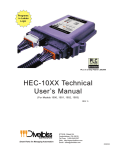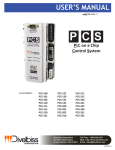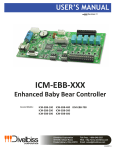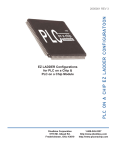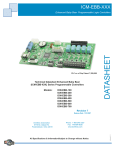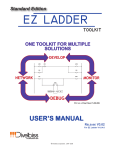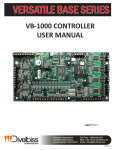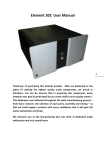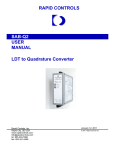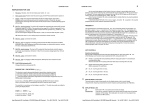Download - Divelbiss Corporation
Transcript
PLC on a CHIP Control System PCS Programs in Ladder Logic PCS Technical User’s Manual PLC on a Chip Patent 7,299,099 REV .2 Smart Parts for Managing Automation 9778 Mt. Gilead Rd. Fredericktown, OH 43019 Toll Free: 1-800-245-2327 Web: http://www.divelbiss.com Email: [email protected] 2006004.2 Table of Contents TABLE OF CONTENTS Table of Contents Page 2 Getting Started How to Use this Manual Part Numbers & Configurations Configuring the PCS Target in EZ LADDER Configuring PWM Properties Page Page Page Page Page 3 4 4 5 6 PCS Features Getting to Know the PCS PCS Mounting PCS Input Power Watchdog LED Power LED Programming Port CAN Ports Real Time Clock High Density I/O Port Counter Inputs Synchronous Serial Interface (SSI) Multi-purpose Serial Port Analog Inputs Analog Outputs PWM Outputs Specifications Page Page Page Page Page Page Page Page Page Page Page Page Page Page Page Page Page 8 9 10 11 11 11 12 12 13 14 15 15 16 16 17 18 19 WARNING! The PCS-XXX, as with programmable controllers, must not be used alone in applications which would be hazardous to personnel in the event of failure of this device. Precautions must be taken by the user to provide mechanical and/or electrical safeguards external to this device. This device is NOT APPROVED for domestic or human medical use. PCS-XXX User’s Manual Document #: 2006004.1.pdf Page 1 of 18 Divelbiss Corporation 9778 Mt. Gilead Rd. Fredericktown, Ohio 43019 1-800-245-2327 www.divelbiss.com GETTING STARTED This section explains how to read this manual and understand the symbols as well as understanding how PCS part numbers are configured. Getting Started HOW TO USE THIS MANUAL In this manual, the following conventions are used to distinguish elements of text: BOLD Denotes labeling, commands, and literal portions of syntax that must appear exactly as shown. italic Used for variables and placeholders that represent the type of text to be entered by the user. SMALL CAPS Used to show key sequences or actual buttons, such as the OK button. OK, where the user clicks In addition, the following symbols appear periodically in the left margin to call the readers attention to specific details in the text: Warns the reader of a potential danger or hazard that is associated with certain actions. Appears when the text contains a tip that is especially helpful. Indicates that the text contains information to which the reader should pay particularly close attention. PART NUMBERS & ORDERING INFORMATION PCS Controller part numbers are configured using options. Each part number contains a Base System, a Serial Port Option and Analog I/O Option. Model Number Configuration: 1 BASE SYSTEM 2 PCS - 2 1 1 2 MULTI-PURPOSE SERIAL PORT 1 3 3 ANALOG I/O 1 256K PLC on a Chip Processor, High Density I/O Interface and Real Time Clock 0 No Serial Port Installed 0 No Analog I/O Installed 1 RS232 Serial Port Installed 1 2 256K PLC on a Chip Processor, High Density I/O Interface, Real Time Clock, 2 CAN Network Ports, SSI Port, 2 High Speed Counter Inputs. 6 Analog Inputs rated 0-5VDC, 4 Analog Outputs rated 0-5VDC & 2 PWM Outputs. 2 RS422 Serial Port Installed 2 6 Analog Inputs rated 0-20mADC, 4 Analog Outputs rated 0-20mADC & 2 PWM Outputs. 3 RS485 Serial Port Installed PCS-XXX User’s Manual Document #: 2006004.1.pdf Page 3 of 18 Divelbiss Corporation 9778 Mt. Gilead Rd. Fredericktown, Ohio 43019 1-800-245-2327 www.divelbiss.com Getting Started CONFIGURING THE PCS TARGET IN EZ LADDER Before you can program and use the PCS Controller, it must be configured as a target within EZ LADDER. For help with installing or using EZ LADDER, please refer to the EZ LADDER User’s Manual. In EZ LADDER, select PROJECT....SETTINGS. This will open the Project Settings Window. Select “PCS-1XX” or “PCS2XX” for the target depending upon the first number of the PCS Model #.. Figure 1.1 show the Project Settings Window. Figure 1.1 Once the “PCS-XXX” target is selected, you must identify which exact model will be used. Click the PROPERTIES button. A drop down dialog box will open with models of PCS-XXX to select from. Select the model that will be used. See Figure 1.2. Figure 1.2 Note: Checkboxes next to features will remind you of the options installed on the selected model. If a model is chosen that includes PWM and Analog Outputs, the PWM must be configured to use PWM or Analog Outputs. If you do not have a model with PWM, you may skip the next part of the configuration by clicking OK to close the Target Properties and click OK to close the ProjectSettingsForm. PCS-XXX User’s Manual Document #: 2006004.1.pdf Page 4 of 18 Divelbiss Corporation 9778 Mt. Gilead Rd. Fredericktown, Ohio 43019 1-800-245-2327 www.divelbiss.com Getting Started CONFIGURING PWM PROPERTIES PCS Controllers with Analog Options include 6 hardware pulse width modulation channels (PWM). Two channels are for PWM only and the other four channels are used as analog outputs.These channels must be installed before they can controlled in the EZ LADDER diagram. To install PWM Outputs in the target configuration: 1. Use the menu, select PROJECT....SETTINGS. The ProjectSettingsForm dialog will open. Select the target. 2. Click the PROPERTIES button. 3. Click the PWM PROPERTIES button. 4. The PWM Properties window will open. See Figure 1.3. Figure 1.3 5. Click the ADD button in the PWM Properties window. 6. In the ADD PWM dialog, select the channels to install. The channels are as follows: AOUT Channel AOUT Channel AOUT Channel AOUT Channel 0 1 2 3 - Install Install Install Install PWM PWM PWM PWM 0 1 2 3 PWM Channel 1 - Install PWM 4 PWM Channel 2 - Install PWM 5 Note: Do not install PWM6 or PWM7 as they are not used. 7. Click OK PCS-XXX User’s Manual to close the ADD PWM dialog. The next step is configuring the frequencies. Document #: 2006004.1.pdf Page 5 of 18 Divelbiss Corporation 9778 Mt. Gilead Rd. Fredericktown, Ohio 43019 1-800-245-2327 www.divelbiss.com Getting Started 8. Enter the desired frequency for Clock A and Clock B (if installed). The PCS has 6 available PWM Channels. Two are used as PWM outputs and 4 are used as analog outputs. These channels are either controlled with Clock A or Clock B. This allows two different PWM frequencies. The Minimum and Maximum frequencies are displayed in the PWM Properties dialog. The frequency for Clock A and Clock B must be in this range. The ACTUAL FREQUENCY is what will be seen on the actual PWM hardware output channels (as close as possible to the desired frequency; this is due to limitations of the hardware). Figure 1.4 9. Click OK to close the PWM Properties and save the changes. 11. Click OK to close the Target Properties and save the changes. 12. Click OK to close the ProjectSettingsForm dialog and save the changes. The PWM channels are now ready for use using the PWM and PWM_FREQ functions. Refer to EZ LADDER Manual - Section 10 for details on using and configuring these functions. For more detail on using the PWM outputs as Analog outputs, refer to Page 17 of this manual. PCS-XXX User’s Manual Document #: 2006004.1.pdf Page 6 of 18 Divelbiss Corporation 9778 Mt. Gilead Rd. Fredericktown, Ohio 43019 1-800-245-2327 www.divelbiss.com PCS FEATURES This section describes the PCS hardware features and options including using EZ LADDER to operate the hardware. PCS Features GETTING TO KNOW THE PCS Multi-purpose Serial Port RS232, RS422 or RS485 Synchronous Serial Interface (SSI) High Density I/O Port (HDIO) CAN O Network Port Digital I/O Expansion Watchdog LED Programming Port CAN 1 Network Port RS232 Null Modem Power LED Input Power is OK 2 Channel High Speed Counter Up to 100 KHz Input Power 10VAC or 12-24VDC Figure 2.1 - PCS Features PCS-XXX User’s Manual Document #: 2006004.1.pdf Page 8 of 18 Divelbiss Corporation 9778 Mt. Gilead Rd. Fredericktown, Ohio 43019 1-800-245-2327 www.divelbiss.com PCS Features PCS MOUNTING The PCS mounts to industry standard DIN Rail. To mount the PCS: 1. Ensure the Din Rail Mounts are pushed in towards the center of the PCS until they snap into position (if not in position already). 2. Angle the PCS with the left side down until the din rail mounts are past the din rail as shown. 3. Using a screw driver, hold open the Din Rail Release and push the PCS flat against the din rail. 4. Remove the tension from the screwdriver and let the Din Rail Release close. The PCS should now be securely mounted to the din rail. 3.55” 2.3” PLC ON A CHIP TM CONTROL SYSTEM CORPORATION 6.22” MODEL #: SERIAL #: Din Rail Mounts Din Rail on a chip TM Embedded PCS MOUNTING - END VIEW Programmable Logic Controller PCS MOUNTING - TOP VIEW Din Rail Release Figure 2.2 - Mounting the PCS To release the PCS from the din rail: 1 Use a screw driver, hold open the Din Rail Release and pull the PCS off the din rail at an angle until the Din Rail Mounts are free. 2. Remove the tension from the screwdriver and let the Din Rail Release close. PCS-XXX User’s Manual Document #: 2006004.1.pdf Page 9 of 18 Divelbiss Corporation 9778 Mt. Gilead Rd. Fredericktown, Ohio 43019 1-800-245-2327 www.divelbiss.com PCS Features PCS INPUT POWER The PCS may be powered using 10 VAC or 12-30 VDC. Apply power to CONN1 using the provided input power cable assembly (PIMS-CA-6). Refer to the input power schematic for details. The transformer shown is optional. Divelbiss recommends a step down transformer, 110 VAC to 10 VAC, @ 2A. The transformer may be purchased from Divelbiss Corporation ( 115VAC Primary: 109-101153, 230VAC Primary: 109-100924) Figure 2.3 - Input Power Connections WATCHDOG LED The operating status of the PCS can be determined the by Watchdog LED. When the Watchdog LED is flashing at a slow rate, approximately once per second, then there is no program executing. When the Watchdog LED is flashing at a fast rate, approximately 10 times per second, a program has been loaded and it is executing. Should the Watchdog LED not flash at all, first check the input power and Power LED. If the input power is correct and there is still no Watchdog LED, contact Divelbiss Technical Services. POWER LED When the Power LED is illuminated, there is sufficient input voltage to allow for proper operation of the PCS. The PCS is protected by a “resettable” fuse. If the fuse should open (the power LED is not illuminated), remove the input power for 30 seconds and then reconnect the input power. The fuse will automatically reset when the power is removed. Please note: while the PCS controller’s input power is not polarity sensitive for operation, the PWR LED is polarity sensitive. If the PWR LED does not operate, but the unit is functional, swap the input power connections. PCS-XXX User’s Manual Document #: 2006004.1.pdf Page 10 of 18 Divelbiss Corporation 9778 Mt. Gilead Rd. Fredericktown, Ohio 43019 1-800-245-2327 www.divelbiss.com PCS Features PROGRAMMING PORT - COM 0 The PCS is programmed using its Programming Port (COM 0). This RS232 serial port is only to be used for programming using Divelbiss’ EZ LADDER. The Programming Port defaults to 57600,N,8,1. This is not a general purpose port. A null modem cable should be used to connect with COM 0. This cable may be purchased from Divelbiss (use Part Number: ICM-CA-34). RS232 Serial Port Module Pin ID 1 2 3 4 5 6 7 8 9 -RX TX -GND -RTS CTS -- Description No Connect Receive Data Transmit Data No Connect Signal Ground No Connect Request To Send Clear To Send No Connect Figure 2.4 - PROGRAMMING PORT - COM 0 Pin-Out CAN PORTS The PCS provides an two optional on-board CAN bus interface ports. These CAN ports support the Divelbiss OptiCan Network and J1939 communications. The CAN ports are connected as shown in Figure 2.5. CAN BUS DEVICE 2 CAN BUS DEVICE 1 LOW Typical 120 Ohms Typical 120 Ohms PCS CAN PORT HI SHD Figure 2.5 - Typical CAN Connections PCS-XXX User’s Manual Document #: 2006004.1.pdf Page 11 of 18 Divelbiss Corporation 9778 Mt. Gilead Rd. Fredericktown, Ohio 43019 1-800-245-2327 www.divelbiss.com PCS Features REAL TIME CLOCK All PCS models include a Real Time Clock. The real time clock (after being set) provides the Month, Day, Day of the Week, Year, Hour, Minute and Second. The real time clock maintains time when power is lost via lithium battery. The Real Time Clock may be accessed using the EZ LADDER functions: GETDATE, GETTIME, SETTIME, SETDATE. The life of the battery for the real time clock generally has years of life before replacement is needed. Should the battery need to be replaced, replace the battery with the same type and size as the original. The battery is a Lithium Coin Cell, Type CR2025. To replace the battery (see Figure 2.6): 1. Remove the PCS from din rail (if necessary). 2. Turn the PCS upside down to gain access to the bottom (mounted side). 3. Using a small flat screwdriver, gently pry and release the latches on the bottom of the PCS. This will allow the bottom insert to be removed giving access to the internal PCS controller printed circuit card. 4. Turn the PCS right side up. The printed circuit cards should easily come out. If they do not slide out easily, check for mouting latches or tabs that may be “binding” the printed circuit cards in place. 5. Slide the battery from the holder and replace with a new battery. Make sure the new battery is in correctly. The Positive (+) should be visible. See Figure 2.7. Figure 2.6 - Disassembly - Bottom Figure 2.7 - Real Time Clock Battery Replacement PCS-XXX User’s Manual Document #: 2006004.1.pdf Page 12 of 18 Divelbiss Corporation 9778 Mt. Gilead Rd. Fredericktown, Ohio 43019 1-800-245-2327 www.divelbiss.com PCS Features HIGH DENSITY I/O PORT (HDIO) The PCS can accept up to 128 Inputs and 128 Outputs using the ICM-HDIO-XX series I/O Expander boards. The ICMHDIO-XX series provides a wide range of input and output types and voltages. The +VA and the 5VDC supply power to the HDIO boards are powered from the PCS. When using a step-down transformer to provide the 10VAC input power, the maximum output power on CONN3 is +VA (12VDC) @ .5A (6 Watts) and 5VDC @ .5A. When using a DC supply to power the PCS controller, the output power on CONN 3 will be 5VDC maximum @ .5A and the +VA (equal to the input power) @ 6 Watts maximum. Please note: Expander board relay coil operating voltage must be within range of the input power to the PCS when using DC power sources or damage to the relays may result due to overvoltage. Ensure proper relays are installed. High Density I/O Expanders use the PCS High Density I/O Port (CONN6 for data and CONN3 for power). These connections are made via cables. The ICM-HDIO-XX boards are din rail mounted and have configurable addresses. The legal I/O addressing for the ICM-HDIO-XX is as follows: Digital Inputs: DI0.00 - DI7.15 Digital Outputs: DO0.00 - DO7.15 The Digital I/O may be accessed using the EZ LADDER objects: DIRECT COIL, INVERTED COIL, DIRECT CONTACT, INVERTED CONTACT. + 1/9 + 2/10 TM + 5/13 + 5/13 + 6/14 + 6/14 + 7/15 + 7/15 + 4/12 + 4/12 + 3/11 PLC ON A CHIP CONTROL SYSTEM + 3/11 + 1/9 + 2/10 + 0/8 + 0/8 +12V COM+5V ICM-HDCA-1X CABLE C OR POR ATION MODEL #: SERIAL #: HIGH DENSITY I/O BOARD (HDIO) on a chip TM Embedded Programmable Logic Controller Figure 2.8 - High Density I/O Connections PCS-XXX User’s Manual Document #: 2006004.1.pdf Page 13 of 18 Divelbiss Corporation 9778 Mt. Gilead Rd. Fredericktown, Ohio 43019 1-800-245-2327 www.divelbiss.com PCS Features COUNTER INPUTS The PCS provides two optional on-board counter inputs (model dependent). These are up counter inputs with capabilites to 100 KHz. It is ideal for connecting flowmeters and other pulse output devices and sensors. The High Speed Counter Inputs use the EZ LADDER function: CNTRTMR. Typical High Speed Counter connections are shown in Figure 2.9. The counter is optically isolated to provide immunity from noise and interference. Isolated High Speed Counter Input SHD Shield PULSE OUTPUT DEVICE Opto-Isolator +DC (12V) +CNT -CNT -DC Figure 2.9 - Typical Counter Input Connections SYNCHRONOUS SERIAL INTERFACE - SSI The PCS provides a Graycode SSI interface for absolute encoders. The SSI interface uses the EZ LADDER function: GC_SSI. When functioning, the GC_SSI block returns an integer value representing the Graycode reading from the encoder. This is read serially, converted from Graycode to a binary number then returned to the block as an Integer output. +D +DATA -DATA +CLOCK -CLOCK -D +C TM PLC ON A CHIP CONTROL SYSTEM -C SHD SHIELD CORPORATION Figure 2.10 - Typical SSI Connections PCS-XXX User’s Manual Document #: 2006004.1.pdf Page 14 of 18 Divelbiss Corporation 9778 Mt. Gilead Rd. Fredericktown, Ohio 43019 1-800-245-2327 www.divelbiss.com PCS Features MULTI-PURPOSE SERIAL PORT - COM 1 The PCS can be purchased with an optional second serial port (multi-purpose port). Factory installed, this port may be ordered as an RS232, RS422 or an RS485 interface and supports baud rates to 115.2K. The Multi-purpose Port is also Modbus slave compatable. The Multi-purpose Serial Port uses Modbus or the EZ LADDER function: SERIAL_PRINT. RS232 Serial Port Module Pin ID 1 2 3 4 5 6 7 8 9 -RX TX -GND -RTS --- Description No Connect Receive Data Transmit Data No Connect Signal Ground No Connect Request To Send No Connect No Connect RS422 Serial Port Module Pin ID 1 2 3 4 5 6 7 8 9 TX--RXGND RX+ --TX+ Description Transmit Data (-) No Connect No Connect Receive Data (-) Signal Ground Receive Data (+) No Connect No Connect Transmit Data (+) RS485 Serial Port Module Pin ID Description 1 2 3 4 5 6 7 8 9 TX---GND ---TX+ Data (-) No Connect No Connect No Connect Signal Ground No Connect No Connect No Connect Data (+) Figure 2.11 - COM 1 - Multi-purpose Port Pin-Outs ANALOG INPUTS The PCS may be purchased with optional factory installed analog inputs. These analog inputs are factory set for 05VDC or 0-20mADC with 10-bit resolution and are buffered. The legal addressing for the Analog Inputs is as follows: AN0 - AN5. Analog inputs are ‘read’ as variables. To use an analog input in the ladder diagram, create a new variable and in the VAR I/O Num, enter the analog channel address. See Figure 2.12. Figure 2.12 - Add Variable - Analog Input When the variable is used in the program, the analog signal will be represented digitally by an integer value of 0-1023 (where 0 is the low end of the scale - approximately 0VDC or 0mADC and 1023 is the high end of the scale -approximately 5VDC or 20mADC). These are raw values; therfore any conditioning (averaging, calibration, etc) must be done in the ladder diagram. Refer to Figure 2.13 for analog input pin assignments and connections. PCS-XXX User’s Manual Document #: 2006004.1.pdf Page 15 of 18 Divelbiss Corporation 9778 Mt. Gilead Rd. Fredericktown, Ohio 43019 1-800-245-2327 www.divelbiss.com PCS Features Figure 2.13 - Analog Input Pin Assignments & Typical Wiring Diagram Connections ANALOG OUTPUTS The PCS may be purchased with optional factory installed analog outputs. These analog outputs are factory set for 05VDC or 0-20mADC with 8 -bit resolution. These terminals are labeled AOUT0 through AOUT3. The PCS analog outputs are controlled in the ladder diagram using the PWM function. The PWM channels are converted to voltage or current depending upon the PCS model. The PCS must have the PWM channels configured in EZ LADDER’s Target Configuration. See Page 6 for configuring the target to use the PWM channels. Figure 2.14 is an example program using the PWM function to control terminal AOUT0. Figure 2.15 is a typical connection diagram. Changing the PWM channel ‘frequency’ (Target Configuration) and the PWM function block’s ‘duty cycle’ will change the analog output’s actual value. You may have to adjust settings several times to meet your desired output. A typical beginning point would be a PWM frequencey of 2Khz. The PWM channel is set to 0 with the PWM0 configured for 2Khz. Changing the ‘DutyCycle’ variable value changes the actual analog output value. Duty Cycle .4% 51.2% 100% Output .4% of total Span 51.2% of total Span Full Output 100% Span Figure 2.14 - Using PWM to Control Analog Outputs PCS-XXX User’s Manual Document #: 2006004.1.pdf Page 16 of 18 Divelbiss Corporation 9778 Mt. Gilead Rd. Fredericktown, Ohio 43019 1-800-245-2327 www.divelbiss.com PCS Features Figure 2.15 - Analog Output - Typical Wiring Diagram PWM OUTPUTS The PCS provides 2 optional PWM outputs. The following specifications apply to the PWM outputs. A PCS-CA-PWM cable is provided to connect PWM channels to off-unit devices. -Open Drain, - Maximum Switch Voltage: 24VDC - Maximum Sink Current: 10mA - Maximum Saturation Voltage: 0.3V @ 0.5mA - Maximum Frequency: 10KHz @ 50:50 Duty Cycle - Minimum Duty Cycle Increment: 0.4% The PCS PWM outputs are controlled in the ladder diagram using the PWM and PWM_FREQ functions. The PCS must have the PWM channels configured in EZ LADDER’s Target Configuration. See Page 6 for configuring the target to use the PWM channels. Figure 2.16 shows the PWM connector and pin-out. Figure 2.17 shows a typical PWM circuit. PIN 1 2 3 4 5 6 7 8 9 10 DESCRIPTION PWM CH 5 -V PWM CH 5 SIGNAL PWM CH 5 +V PWM CH 4 -V PWM CH 4 SIGNAL CH 4 +V Not PWM Connected Not Connected Not Connected Not Connected Not Connected Figure 2.16 - PWM Pin Assignments PCS-XXX User’s Manual Document #: 2006004.1.pdf Page 17 of 18 Divelbiss Corporation 9778 Mt. Gilead Rd. Fredericktown, Ohio 43019 1-800-245-2327 www.divelbiss.com PCS Features +V (External Voltage Source) PULL UP RESISTORS (If Required) PCS PWM OUTPUT CONNECTOR 6 PWM Channel 4 Signal to Load Device Circuitry 5 4 3 PWM Channel 5 Signal to Load Device Circuitry 2 1 COMMON (External Voltage Source) Figure 2.17 - Typical PWM Circuit SPECIFICATIONS Processor: Memory: Serial Ports: Networking: Digital I/O: Real Time Clock: Counters: Analog Inputs: Analog Outputs: PWM Outputs: Power Requirements: Operating Temp: I/O POWER: Program Language: Dimensions: Mounting: Type: Temperature: PCS-XXX User’s Manual PLC on a ChipTM 256K Flash, 12K RAM 2 Serial Ports - 1 RS232 Programming Port (Max baud: 57.6K); 1 RS232/RS422/RS485, (Max Baud:115.2K). Supports Modbus Slave 2 CAN Ports, Supports Divelbiss OptiCan, J1939 Up to total 128 Inputs and 128 Outputs using High Density I/O Time of Day, Day, Month, Year & Day of Week 2 Channels, Count Up, 100KHz Max. 6 Channels, 10-bit Resolution, rated 0-5VDC or 0-20mADC 4 Channels, 8-bit Resolution, rated 0-5VDC or 0-20mADC 2 Channels Open Collector Output 1.436 Hz to 47.058KHz 115VAC with Optional Transformer, 10 VAC or 10-30VDC 0-60º C With 10VAC Power, +VA (12VDC) @ .5A Max, 5VDC @ .5A Max. With DC Input, +VA (equal to power in) @ 6 Watts Max, 5VDC @ .5A Max. Ladder Logic using Divelbiss EZ LADDER. 3.6” Wide x 6.2” Length x 2.3” Tall. DIN Rail Mount Enclosed, Plastic Housing 0-60ºC Document #: 2006004.1.pdf Page 18 of 18 Divelbiss Corporation 9778 Mt. Gilead Rd. Fredericktown, Ohio 43019 1-800-245-2327 www.divelbiss.com



















